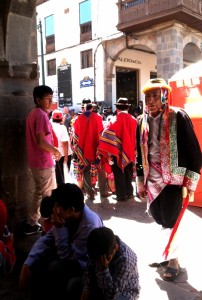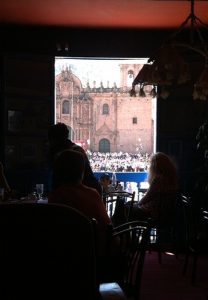A Battle of Culture and Market Share: Merchants Dance around the Plaza Today.

Most days the caseras, vendors, in Cuzco’’s markets sit by their mounds of produce trying to attract buyers from among the people who file through the narrow aisles. Today, however, they are dressed in costume and parade around Cuzco’s main square, its Plaza de Armas.
To the sound of drums and flutes they move rhythmically as they take on the roles of different figures from Cuzco’s folk culture. They compete to have the best costumes and to dance the best representations of the regions of Cuzco and its folk figures.
They join with commercial centers, such as the El Paraiso shopping center to fill the plaza with joy, energy, and color.

The announcer trumpets in Spanish and Quechua that they are rendering homage to Cuzco, the land of the royal panacas, the kin groups, of the Incas, those elites who made a great empire. However the city also honors them and recognizes them as an important part of it, something that is especially important right now as the mall and large, national and even multinational stores challenge the claim these merchants have on Cuzco’s publics.
A struggle, like that from so many places between local stores and large enterprises, is developing in which both will claim to be most important for Cuzco’s economy. The grand merchandisers will claim to provide jobs and will bring international glitz and marketing power, while the locals will claim to leave profits in Cuzco and thus generate more jobs and more local economy.

In this developing life or death struggle for the loyalty of Cuzco’s customers, the war will be over local values and the relationship of the business to local culture and ideals.
Although the markets, with their organizations like guilds focused around devotion to a particular saint, have danced or just paraded around the plaza for generations, the mall with its big stores–Oechsle, Plaza Vea, Tanta, Chilis, Cineplanet, and so on–will try to undercut their hold on local culture and hearts. The market vendors and small scale commercial centers can claim to represent local history and local values, local myths and heros, in a way that the large ones will try to imitate and take over.

It will be a battle of televised marketing versus parades around the Plaza, until the mall demands to join the parade and bring in televised figures and celebrities. It is a battle of unequals.
For the time being, today, the city honors its markets and its small scale merchants. They gather in the Regocijo Park, dressed as indigenous figures to dance. Cow horns sound and they move forward as one market organization after another pulses forward.
The flutes and drums claim an ancient past, but the marketing giants are amassed, waiting to claim this space of authenticity for them and their commerce. The battle is joined.
The big guys, though, will never even acknowledge there is a battle. They will put up advertising in the media, and stages in the mall with national and international touring groups. They will claim to be Peru, and even Cuzco. They will claim the Incas and hope their marketing power claims the purchases and imaginations of Cuzqueños so the competition, the markets and smaller merchants wither, without ever being able to have the pleasure of a good battle, one on one, in the old and celebrated style.




